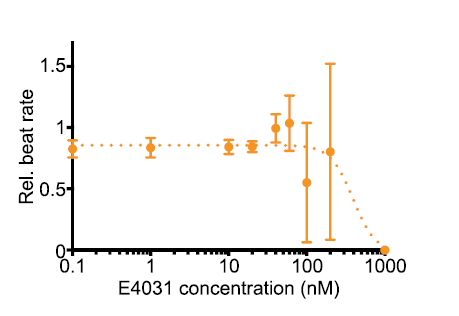- You are here: Home
- Services
- Drug Toxicity Services
- In Vitro Cardiotoxicity
- 3D Cardiovascular Toxicity Service
Services
-
Cell Services
- Cell Line Authentication
- Cell Surface Marker Validation Service
-
Cell Line Testing and Assays
- Toxicology Assay
- Drug-Resistant Cell Models
- Cell Viability Assays
- Cell Proliferation Assays
- Cell Migration Assays
- Soft Agar Colony Formation Assay Service
- SRB Assay
- Cell Apoptosis Assays
- Cell Cycle Assays
- Cell Angiogenesis Assays
- DNA/RNA Extraction
- Custom Cell & Tissue Lysate Service
- Cellular Phosphorylation Assays
- Stability Testing
- Sterility Testing
- Endotoxin Detection and Removal
- Phagocytosis Assays
- Cell-Based Screening and Profiling Services
- 3D-Based Services
- Custom Cell Services
- Cell-based LNP Evaluation
-
Stem Cell Research
- iPSC Generation
- iPSC Characterization
-
iPSC Differentiation
- Neural Stem Cells Differentiation Service from iPSC
- Astrocyte Differentiation Service from iPSC
- Retinal Pigment Epithelium (RPE) Differentiation Service from iPSC
- Cardiomyocyte Differentiation Service from iPSC
- T Cell, NK Cell Differentiation Service from iPSC
- Hepatocyte Differentiation Service from iPSC
- Beta Cell Differentiation Service from iPSC
- Brain Organoid Differentiation Service from iPSC
- Cardiac Organoid Differentiation Service from iPSC
- Kidney Organoid Differentiation Service from iPSC
- GABAnergic Neuron Differentiation Service from iPSC
- Undifferentiated iPSC Detection
- iPSC Gene Editing
- iPSC Expanding Service
- MSC Services
- Stem Cell Assay Development and Screening
- Cell Immortalization
-
ISH/FISH Services
- In Situ Hybridization (ISH) & RNAscope Service
- Fluorescent In Situ Hybridization
- FISH Probe Design, Synthesis and Testing Service
-
FISH Applications
- Multicolor FISH (M-FISH) Analysis
- Chromosome Analysis of ES and iPS Cells
- RNA FISH in Plant Service
- Mouse Model and PDX Analysis (FISH)
- Cell Transplantation Analysis (FISH)
- In Situ Detection of CAR-T Cells & Oncolytic Viruses
- CAR-T/CAR-NK Target Assessment Service (ISH)
- ImmunoFISH Analysis (FISH+IHC)
- Splice Variant Analysis (FISH)
- Telomere Length Analysis (Q-FISH)
- Telomere Length Analysis (qPCR assay)
- FISH Analysis of Microorganisms
- Neoplasms FISH Analysis
- CARD-FISH for Environmental Microorganisms (FISH)
- FISH Quality Control Services
- QuantiGene Plex Assay
- Circulating Tumor Cell (CTC) FISH
- mtRNA Analysis (FISH)
- In Situ Detection of Chemokines/Cytokines
- In Situ Detection of Virus
- Transgene Mapping (FISH)
- Transgene Mapping (Locus Amplification & Sequencing)
- Stable Cell Line Genetic Stability Testing
- Genetic Stability Testing (Locus Amplification & Sequencing + ddPCR)
- Clonality Analysis Service (FISH)
- Karyotyping (G-banded) Service
- Animal Chromosome Analysis (G-banded) Service
- I-FISH Service
- AAV Biodistribution Analysis (RNA ISH)
- Molecular Karyotyping (aCGH)
- Droplet Digital PCR (ddPCR) Service
- Digital ISH Image Quantification and Statistical Analysis
- SCE (Sister Chromatid Exchange) Analysis
- Biosample Services
- Histology Services
- Exosome Research Services
- In Vitro DMPK Services
-
In Vivo DMPK Services
- Pharmacokinetic and Toxicokinetic
- PK/PD Biomarker Analysis
- Bioavailability and Bioequivalence
- Bioanalytical Package
- Metabolite Profiling and Identification
- In Vivo Toxicity Study
- Mass Balance, Excretion and Expired Air Collection
- Administration Routes and Biofluid Sampling
- Quantitative Tissue Distribution
- Target Tissue Exposure
- In Vivo Blood-Brain-Barrier Assay
- Drug Toxicity Services
3D Cardiovascular Toxicity Service

The drug-induced cardiovascular complications restrict the use of many successful clinical treatments such as anticancer therapies. The majority drug-induced cardiovascular complications include overt cardiac dysfunction as well as some negative impact such as hypertension, ischemia, and arrhythmias. Enormous efforts and investments have been made throughout the process of new drugs development to identify adverse effects of cardiovascular systems and minimize the risks for patients. Interspecies differences in ion channel composition and signal cascades can hinder the predictivity of the cardio-toxicity test by using non-human experimental models. Traditional 2D cell culture models cannot recapitulate the human in vivo structure and organization of the myocardium and are lack of the crucial process of cardiomyocyte differentiation. To overcome the weaknesses and limitations of current cell-based and animal-based testing, 3D models with the appropriate biophysical tissue architecture are generated for cardio-toxicity test in order to provide highly predictive and detailed information for the human in vivo study. Creative-Bioarray offers the opportunity for highly predictable pre-clinical cardio-toxicity testing to help our customers to reduce both the cost and duration of bringing a new drug candidate to market.
Creative Bioarray 3D cardiovascular assay service advantages
- 3D structure of cardiac cell models can be more representative of in vivo tissue than traditional monolayer cell culture.
- Capable of providing several physiologic model systems of 3D culture made by cell lines, human iPS cells and ES cells for you to choose.
- Able to cover most test endpoints for cardio-toxicity test.
Workflow

Applications
Creative-Bioarray tests your target compound with a series concentration. We focus on a wide range of test endpoints include: QT interval, beat rate change, contraction rate and duration as well as the compound impact on different ion channels, which allow you to better characterize your compounds.
Study examples
 Figure 1. The representative data analysis for the detection of APD-prolongation effects of compound E4031
Figure 1. The representative data analysis for the detection of APD-prolongation effects of compound E4031
 Figure 2 The representative data analysis for the dose-dependent decrease in beat rate of E4031 treatment
Figure 2 The representative data analysis for the dose-dependent decrease in beat rate of E4031 treatment
Quotations and ordering
Our customer service representatives are available 24hr a day!
See other In Vitro Cardiotoxicity at Creative Bioarray.
References
- Barros-Gomes, S., et al. Rationale for setting up a cardio-oncology unit: our experience at Mayo Clinic. Cardio-Oncology. 2016, 2.1: 5.
- Jahnke, H., et al. A novel 3D label-free monitoring system of hES-derived cardiomyocyte clusters: a step forward to in vitro cardiotoxicity testing. PloS one. 2013, 8.7: e68971.
- Mathur, A., et al. Human iPSC-based cardiac microphysiological system for drug screening applications. Scientific reports. 2015, 5: 8883.
Explore Other Options
For research use only. Not for any other purpose.

